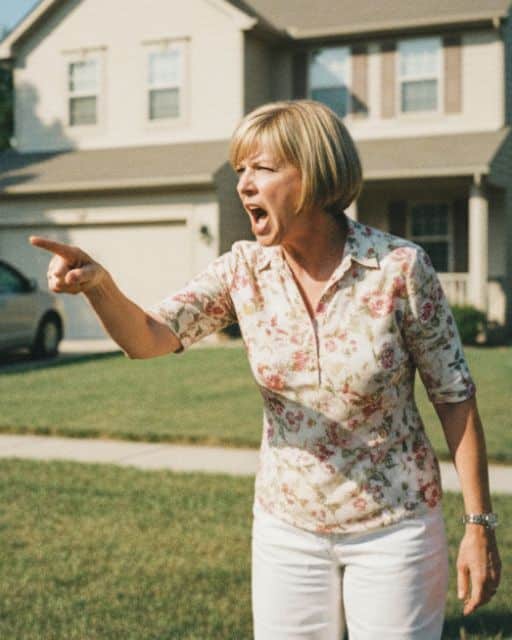Every week, it was something. Lawns “too long.” Music “offensive.” Trash cans “not aesthetically aligned.” Karen—what we all called her—didn’t just complain; she archived. Photos. HOA emails. Lectures to delivery drivers. She even called animal control on my cousin’s nine-year-old for walking a leashed cat.
Yesterday, she picked a fight with the new family on the corner. Quiet couple. Their daughter—maybe eleven—had covered the sidewalk in chalk: flowers, stars, a rainbow.
Karen stormed over. “This is VANDALISM!”
The girl stared, then slipped inside.
Five minutes later, she returned with her dad. Tall, unflappable. He crouched, studied the chalk, and met Karen’s glare with a smile that wasn’t a smile.
“Pretty creative vandalism, don’t you think?”
“Sidewalk chalk is a gateway to graffiti,” Karen huffed. “This is a neighborhood, not an art fair.”
He didn’t argue. “Noted.” He took his daughter’s hand and went back inside. Karen strutted off like she’d won something. But the dad’s calm made the whole block uneasy.
That night the drawings multiplied. Not just a rainbow—whole scenes. A castle. A dragon. A meadow. The colors rolled down the concrete like a story told in light.
Morning brought Karen’s shriek. “DESTRUCTION OF PROPERTY!” She filmed. Neighbors drifted out. In big, neat letters, the girl had added a message:
Every flower grows, no matter who steps on it.
Karen’s face went crimson. She stomped across the art, smearing colors under her shoes. The girl watched from the porch. No tears. No fear. Just watching.
By evening the photos were in the neighborhood group. Likes. Shares. Comments about how talented the girl was. People drove by to see. Karen hated it.
Next day she came with a bucket and scrub brushes. “This ends now!” Water sloshed. Before she could finish, the girl’s mom stepped outside, as calm as her husband.
“Karen,” she said gently, “you need to stop.”
“She’s defacing public walkways!”
“She’s brightening them. And you’re making a fool of yourself.”
Phones were already up. Videos of Karen washing away children’s art spread faster than the chalk had. By nightfall she was the villain of every local chat.
The girl didn’t stop. Her drawings got braver. A sun in front of the widow’s house. A giant heart for the couple with a newborn. A grinning dog in front of my cousin’s. People started leaving out chalk for her. The sidewalks bloomed.
Karen tried the HOA. They shrugged. She called the police. They laughed. An officer came back later with his kids to see the drawings.
Then came the final blow.
Saturday morning, the girl drew in front of Karen’s house. We heard the scream and gathered, expecting flowers. Instead, there was a mirror: a life-sized chalk figure with crossed arms, a scowl, angry eyes—Karen to the bone. Above it, in looping script:
Some flowers refuse to bloom.
Silence. Karen stared. No rant. No phone. She turned, went inside, and stayed there for days.
We braced for lawyers, bans, some crusade. Nothing. For the first time, Karen was quiet.
A week later she came out with a small box of chalk. No cameras. No speeches. She sat on her steps and drew a crooked little flower.
The girl walked by, paused, and smiled. No words.
Karen didn’t become friendly, exactly. But she stopped the constant complaints. Sometimes she even waved. It wasn’t everything, but it was something.
The girl kept drawing. Pumpkins in October. Snowflakes in December. Tulips in spring. The sidewalks changed with the seasons and so did we. Her chalk wasn’t just art; it was permission. It connected people who barely nodded before.
I think about it a lot—how fear and control can cow a street for a while, but color and kindness always crack through. When I see kids with chalk now, I don’t tell them to stop. I kneel, take a piece, and add a star.
If this made you smile, pass it on to someone who needs a reminder: a little color can change a whole block.
